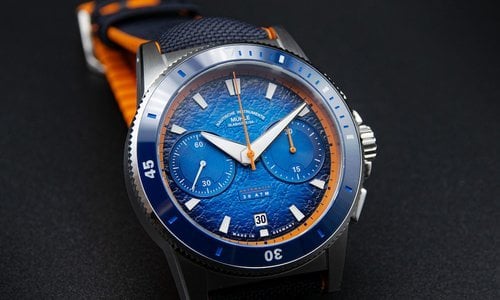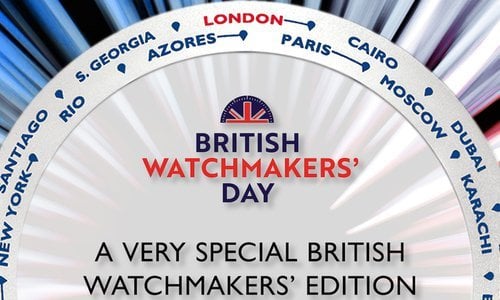In the space of two years, sales of Swiss watches in Hong Kong have halved, and the title of global market leader passed to the United States in July. In September, Europa Star went to Hong Kong’s 35th watch fair to investigate. Read on for analysis, commentary, interviews and revelations.

Flashback: in 2008, sales of Swiss watches were booming in China, and in Hong Kong in particular, where 80 to 90 per cent of buyers are Chinese. The watch craze lasted six years, new millionaires seemed insatiable and watchmakers struggled to keep up with demand, and even more so with after-sales services. Every year, new records were set and Asia accounted for half of its worldwide exports. Little Switzerland, supported by its watchmaking industry, even went as far as racking up a trade surplus to rival the Chinese export empire. But on 14 March 2013, Xi Jinping was elected to the presidency and put an end to such exuberance. “His war against corruption in the People’s Republic of China was waged through the stigmatisation of luxury products, and watches in particular,” Esther Wong, president of The Federation of Hong Kong Watch Trades, tells us. In 2014, members of the public found great amusement online by identifying and valuing the watches worn by local government officials in all provinces – some had entire collections. Such excess was seen as a barometer of corruption. The result: some 1,500 party officials faced corruption charges and more than 200 were found guilty. But as corruption has worsened in China (according to Transparency International), Xi Jinping is suspected of having primarily removed his reformist opponents in order to avoid a potential collapse of communism, USSR-style.
SHOP TALK
For the watch industry, regardless of Xi Jinping’s intentions, the damage is done and the downturn is affecting the luxury sector in particular, as our tour of watch shops in Hong Kong has confirmed. As we could have predicted, all the sales assistants we spoke to insisted on keeping their anonymity. Ms Tang works in a shop selling 32 luxury brands, with an upmarket range including HYT, Harry Winston and Ulysse Nardin, and a lower-end range featuring Baume & Mercier and Oris. “Our Chinese customers tell us that frankly, they no longer want a watch as a status symbol,” says the sales manager. “But we’re suffering less than the single-brand luxury stores because we can always suggest an alternative in the form of a niche model or a more ordinary brand,” she adds, mentioning Rolex and TAG Heuer. Is it true that brands are recalling stock on consignment? “Not at our shop in any case, all the items have been paid for,” she replies, eyes wide. And has the grey market grown? “It has always existed. We have major Asian customers, but as demand has decreased, the grey market has also slowed,” Miss Tang reassures us, adding, “And we don’t sell at a discount either.” In the most opulent Hong Kong store, Miss Cheung admits to a fall in sales that “is said to be due to a massive drop in the number of Chinese tourists,” and laments “that we don’t have more young people come into the shop.” Next, we knocked at the door of an exclusive retailer. Surrounded by ceramic Longeau watches, David welcomes us full of optimism. “Business is going well and our stock hasn’t been recalled,” he says. “Furthermore, we’re benefiting from a recent rent reduction and our costs have been cut by a third.” Has this included job losses? “Not for us, but it seems that some retail chains now just employ sales assistants and then a single manager covers all of their stores.”
However, rents aren’t decreasing everywhere and this could even cost young Yoko her job managing a small store in a shopping centre. “Even if I were to sell a fashionable and inexpensive brand, the charges would become too costly,” she says. Has the drop in sales also affected plastic watches? Yoko shrugs her shoulders. “Maybe young people today prefer an Apple watch.” The other retailers we visited wouldn’t tell us more, or refused to talk to us at all, with a curt ‘no comment’. As enlightening as it was to visit these shops, we’re still sceptical that the vendors are in a position to be objective, or even that they really understand what’s going on. One thing is certain: exorbitant rent prices in Hong Kong (among the highest in the world) rapidly become unendurable as business slows – which has been the case since the ‘Umbrella Revolution’ two years ago, when Chinese tourists began to disappear. On the subject of store closures, Esther Wong from the Federation of Hong Kong Watch Trades states, “It’s difficult to quantify exactly, but around 10 watch shops have closed in Hong Kong this year. As the phenomenon is affecting all the local industries, some landlords have agreed to immediately lower rent by around 20 per cent.” An unprecedented move.
SMARTWATCHES: A HOLLOW DEBATE
We’re back at the famous Hong Kong Convention and Exhibition Center where, as part of the watch fair, an exhibition has brought together the presidents of the major watch federations. For the past two or three years, the same participants have repeated the same speeches on the same subjects with the same aim of reassuring audiences. None of them wants to believe that we are witnessing a new watch industry crisis, threatened by the arrival of the smartwatch. “No,” insists Jean-Daniel Pasche, president of the powerful Federation of the Swiss Watch Industry, “the smartwatch is supplementary and utilitarian, and so doesn’t compete with the watch industry, which seeks to incite emotion.” Indeed, as each model quickly becomes obsolete and its style is dominated by the screen, the smartwatch has no chance of conferring the same status as a classic watch. “We also know that customers often have several watches, each worn for a different activity. Consequently, the smartwatch doesn’t exclude the traditional watch, it complements it,” Pasche maintains.
Admittedly, given that it requires daily charging and pairing with a smartphone (to provide additional features), the smartwatch is a pure gadget. In reality, it’s the smartwatch (and by extension the smartphone) that is threatened by the arrival of future technologies such as smartglasses, smartlenses, smart implants, etc. Pasche drives home this point, saying, “If this weren’t the case, the lower-end segment of the Swiss watch industry would have been directly affected. And yet this is the market segment that has best withstood the market. Even though it is a bear market.”
The question that is secretly gnawing away at the presidents of the watch federations, far more than the smartwatch issue, is the question of symbolism.
A DECADENT SYMBOL?
For a long time, the wristwatch was as strong a symbol of masculinity as the cigarette was in the 1960s. A symbol of virility, power, elegance, individuality, intellectualism, adventure, rebellion–the language used to describe both was exactly the same. And yet smoking has become taboo and even James Bond has ditched the cigarettes, if not his beloved Martinis. So what does the future hold for the wristwatch?
New consumers are now from generations X, Y, and Z. Well, for the parents of generation X and Y children (born between 1960 and 1990), the wristwatch was already losing its influence as a status symbol. I personally witnessed this in the 1980s when, as a child born right in the middle of generation X, I saw my father, then a tennis champion, win many magnificent watches from sponsors. In my eyes, a branded watch was an extension of your personality. But I was surprised to see that more and more, my friends’ parents shamelessly wore the first Swiss anti-watch, the Swatch. Triumphant, the disposable and impersonal plastic watch credited with ‘saving the Swiss watch industry’ also removed its soul. Two generations later, the fathers of generation Z boys (born after 1995) have relegated the watch to the level of an optional accessory for men. Inevitably, if parents do not pass on a symbol to their children, the symbol dies. It is now easy to see why watch industry federations do not frown upon the arrival of the smartwatch: reintroducing young people to the concept of wearing an object on their wrists could be the best way to bring them back into the fold of the traditional watch industry, which, for its part, is also reaching out to young people by launching its first connected models.
Studying generation Z, understanding generation Z, predicting generation Z, these creatures are at the centre of every marketing study. Why? Because they’re ‘digital natives’; the first generation to be entirely surrounded by technology and the generation who will shape the future. In their new world of social networks, generation Z has developed a heightened sense of community values, broken down social barriers, and ended both the class war and gender inequality. But be careful, generation Z is unpredictable, defiant, consumerist, and narcissistic! Anyone for a selfie? Its loyalty to a brand is fleeting, and if a brand makes even the slightest faux-pas, it is immediately picked up on. Intuitively surfing the web on touchscreens, the brain has developed new abilities and, in no time at all, generation Z has realised the pointlessness of the smartwatch and published all its weaknesses online. The manufacturers are kindly asked to go back to the drawing board.
THE EXCEPTION TO GENERATION Z
In China, the fathers of generation X and earlier dreamt of owning the ‘three machines’ – bicycle, sewing machine, and watch – but this dream only came true for a tiny minority. The concept of a wristwatch as a status symbol was therefore not passed down from father to son. Even the smartwatch is rarely seen on the wrists of younger generations, with the exception of a few tech geeks. Suddenly, in the streets of Shijiazhuang, the capital of Hubei province (300 km south-west of Beijing), a ‘Z’ appears wearing a Swatch Sistem 51! For Yunkai Qiu, a 19-year-old Chinese student, “an affordable automatic watch is a must.” And your friends? “I’m a bit of a double exception: hardly anyone wears a watch and even fewer wear a mechanical watch. Students avoid unnecessary expenses and already have the exact time on their smartphone.” But once they join the world of work, will they buy a Mido, Titoni, or even a Swatch ? “I doubt it,” replies Yunkai. “Young people are used to checking their phones all the time, even to find out the time. I’m unusual in China because I like tradition. So it probably won’t surprise you to learn that I’m studying Chinese medicine.”
It’s clear that the boom years of the watch industry in China involved not the younger generations, but rather the older ones, those who had dreamt of a watch before becoming rich. The explosion of shops in China has not created a lasting culture for wristwatches.
Source: Europa Star 5/16 Winter 2016 Magazine Issue
Europa Star conducted a watchmaking tour of three key markets which lie at a business crossroads: Hong Kong, the historical global hub currently living through a very difficult phase; the United States, which has conquered anew the top spot in terms of imports of Swiss made watches; and finally, Italy, the primary European destination for Swiss watchmakers.







